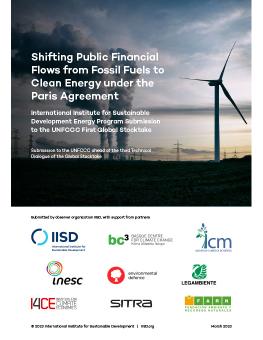
Shifting Public Financial Flows From Fossil Fuels to Clean Energy Under the Paris Agreement
International Institute for Sustainable Development Energy Program Submission to the UNFCCC First Global Stocktake
The first UNFCCC Global Stocktake process-which will conclude at COP28 in Dubai-intends to evaluate progress towards achieving the goals of the Paris Agreement and increase national ambitions to speed up climate action. This report is the IISD Energy Program's submission to the first Global Stocktake, assessing global progress made on shifting public finance flows from fossil fuels toward clean energy. It finds that despite the countries' pledges, fossil fuel subsidies have continued to rise since 2015—exceeding USD 1 trillion for the first time in 2022—and provides recommendations to help overcome challenges to shifting public financial flows towards clean energy.
This submission to the first formal United Nations Framework Convention on Climate Change Global Stocktake provides evidence of the extent to which parties have made progress on aligning public financial flows—including subsidies, investments by state-owned enterprises (SOEs), and lending from public financial institutions—with the need to reduce emissions in line with climate targets.
Commitments on shifting financial flows have not fared well during the COVID-19 and energy crises. According to the Fossil Fuel Subsidy Tracker, fossil energy subsidies reached USD 732 billion in 2021, 35% higher than in 2015, the year of the Paris Agreement (USD 543 billion). They further jumped to USD 1.1 trillion in 2022, according to the International Energy Agency's preliminary estimate that does not cover all countries and includes only consumer subsidies, so the final value of fossil fuel subsidies for 2022 will be even higher.
Yet, fossil fuel subsidies hinder the implementation of the Paris Agreement because they create incentives to produce and consume more fossil fuels, increasing greenhouse gas emissions. They also they skew the level playing field for investing in and deploying clean energy technologies. It is sometimes claimed that they are needed to support low-income households—while research shows that the biggest benefits often accrue to the wealthiest groups.
These subsidies are also often extremely costly, consuming public resources that could instead be used to support the poor more efficiently (such as health and education services) or to address climate change mitigation and adaptation.
Shifting public support away from fossil fuels can be a source of positive social and environmental changes, but in many cases, it needs to be carefully planned or it can have negative socioeconomic impacts.
The following steps can help overcome challenges to shifting public financial flows towards clean energy:
- Improving the state of transparency.
- Improving the accountability of global commitments on shifting public support from fossil fuels to clean energy.
- At the national level, good planning is essential: getting the prices right, managing impacts, and building support.
You might also be interested in
Unlocking Supply Chains for Localizing Electric Vehicle Battery Production in India
This study aims to highlight the key supply chain barriers in localizing electric vehicle (EV) battery cell manufacturing in India. It summarizes consultations with 12 companies, as well as experts and policy-makers, to determine the crucial challenges and opportunities in localizing battery manufacturing in India.
COP 29 Must Deliver on Last Year’s Historic Energy Transition Pact
At COP 29 in Baku, countries must build on what was achieved at COP 28 and clarify what tripling renewables and transitioning away from fossil fuels means in practice.
IISD Welcomes Draft Regulations for Oil and Gas Pollution Cap
A firm cap on emissions can provide certainty for industry to invest in decarbonization, while ensuring the sector is on a path to net-zero by 2050.
Capping Potential Blowouts
This policy brief argues that the oil and gas emissions cap is necessary but cautions that some of its compliance flexibilities may amount to a critical weakening.